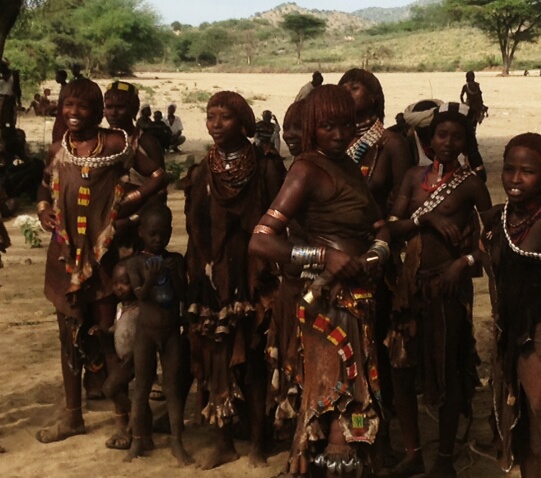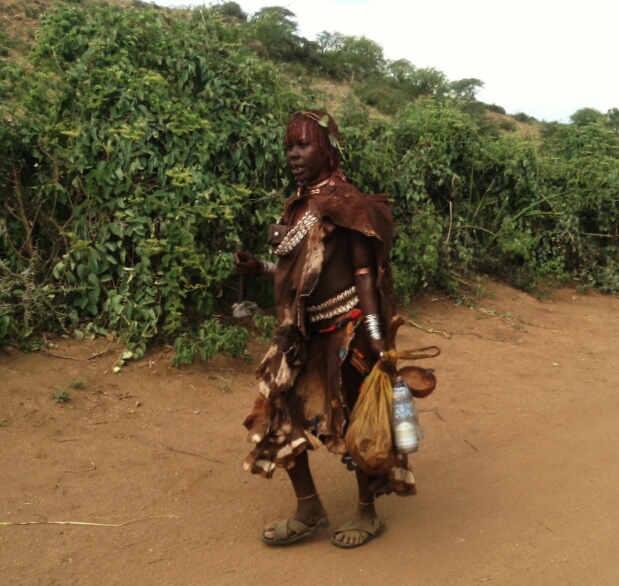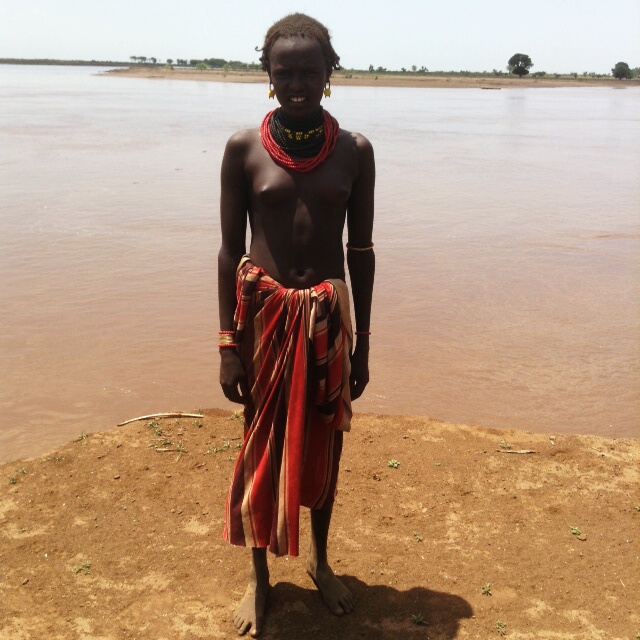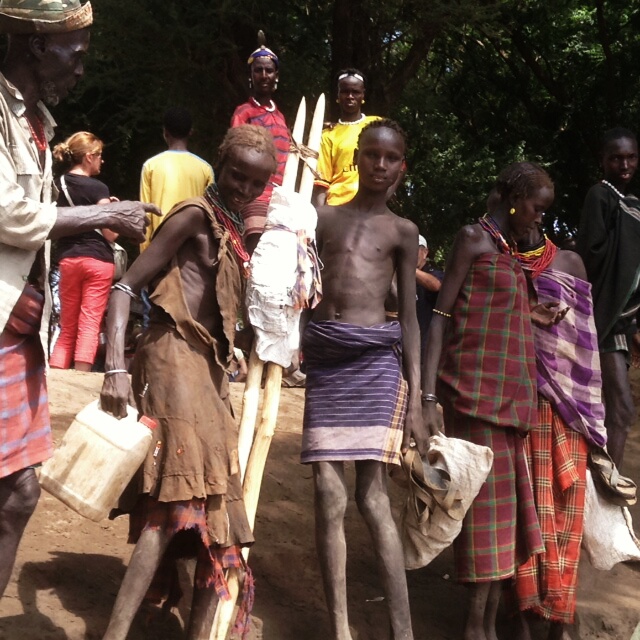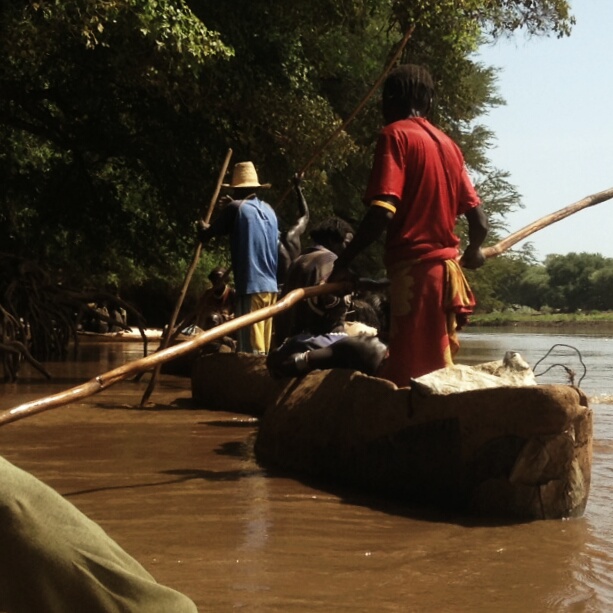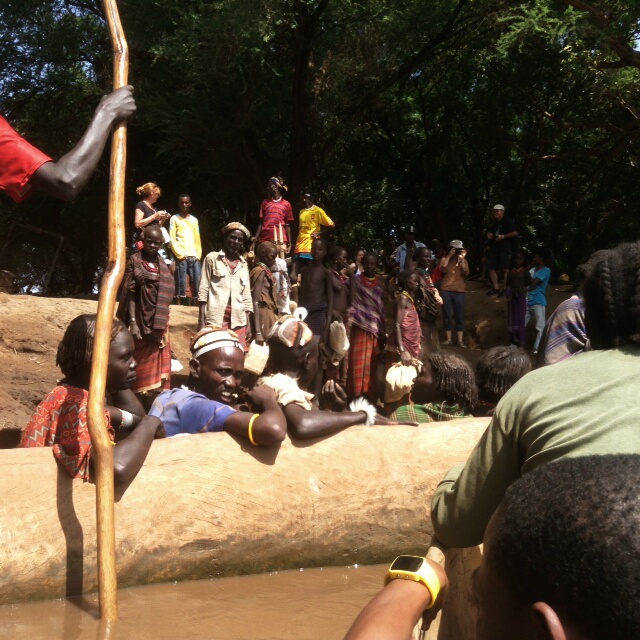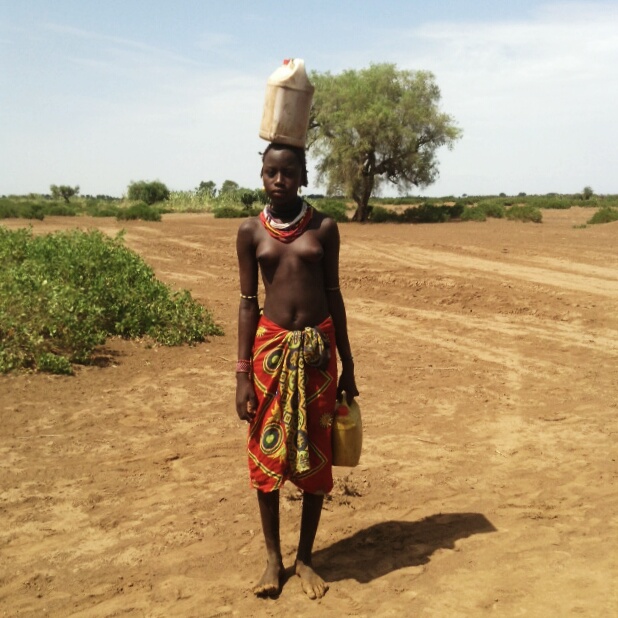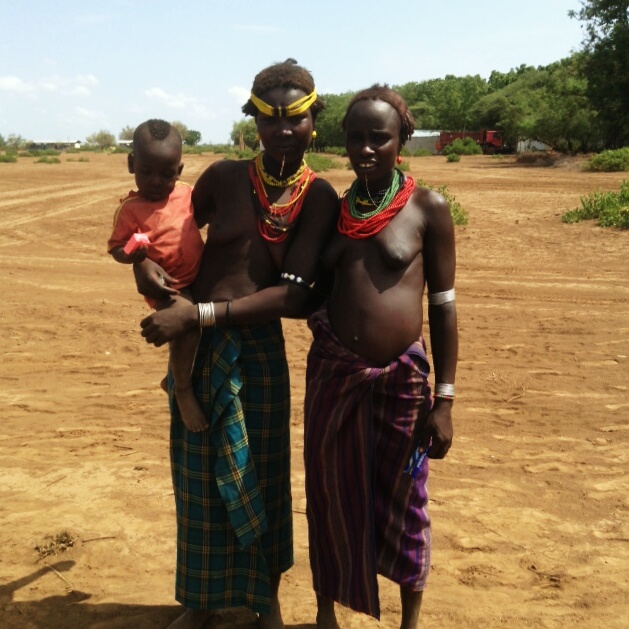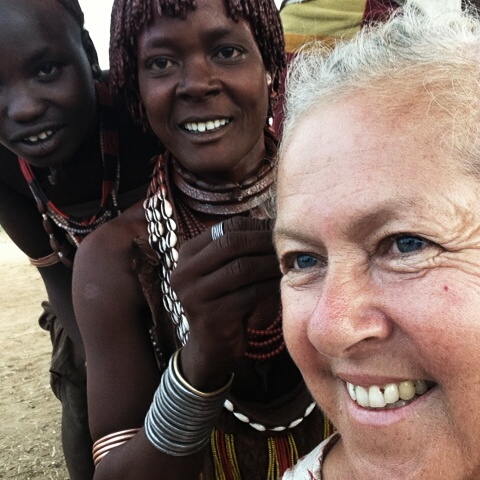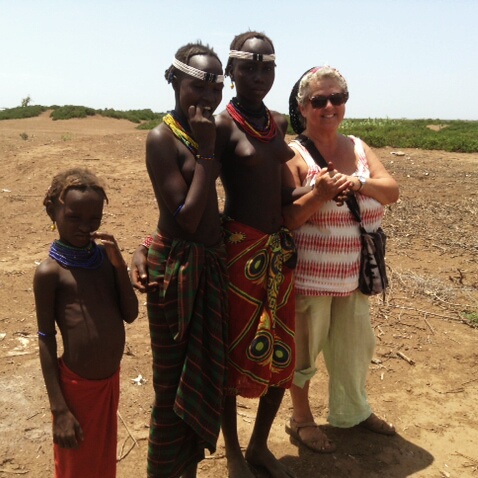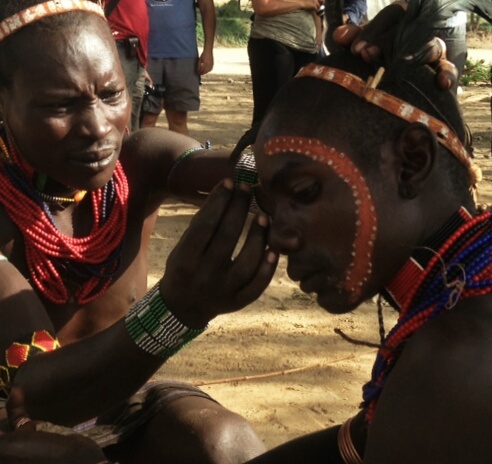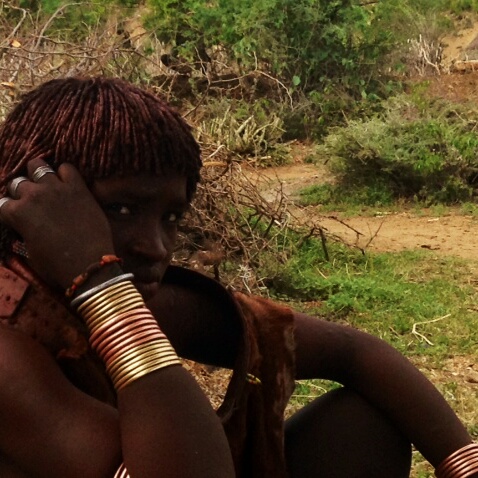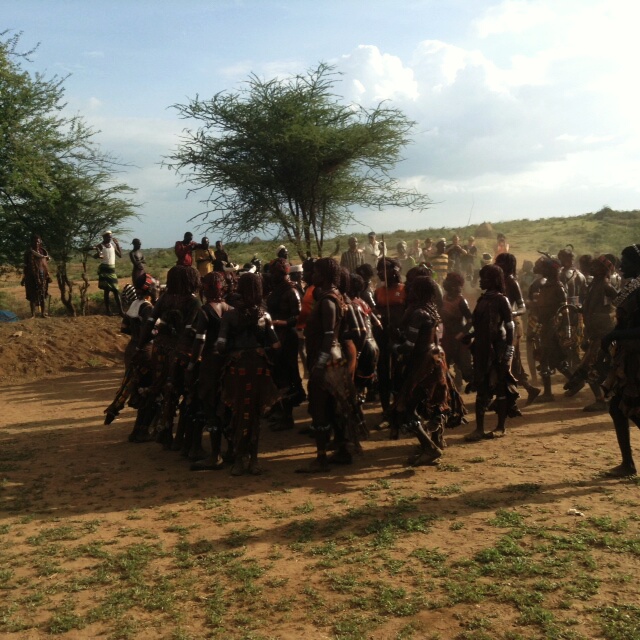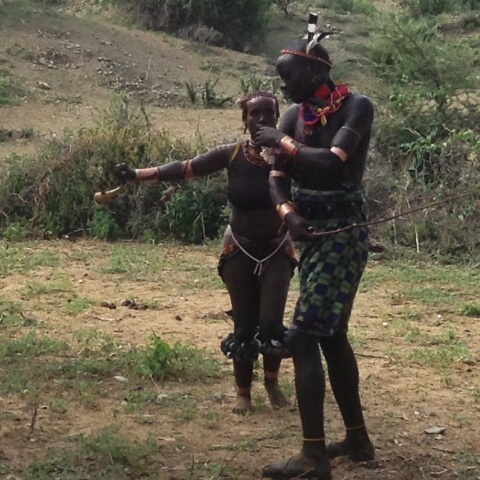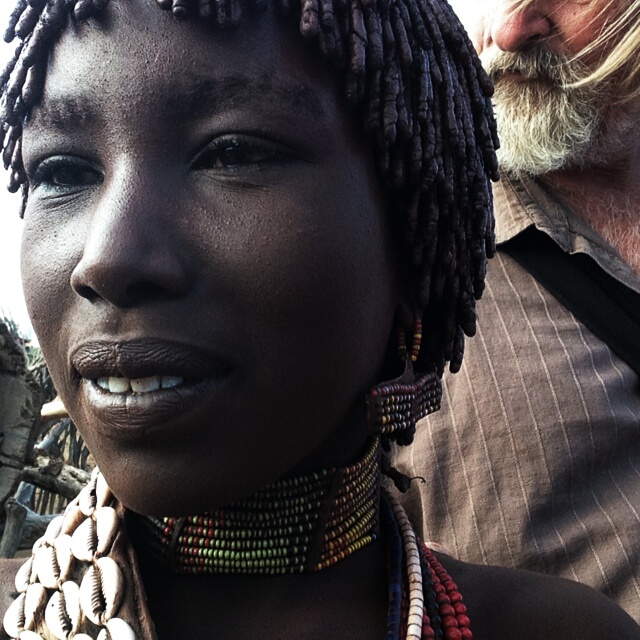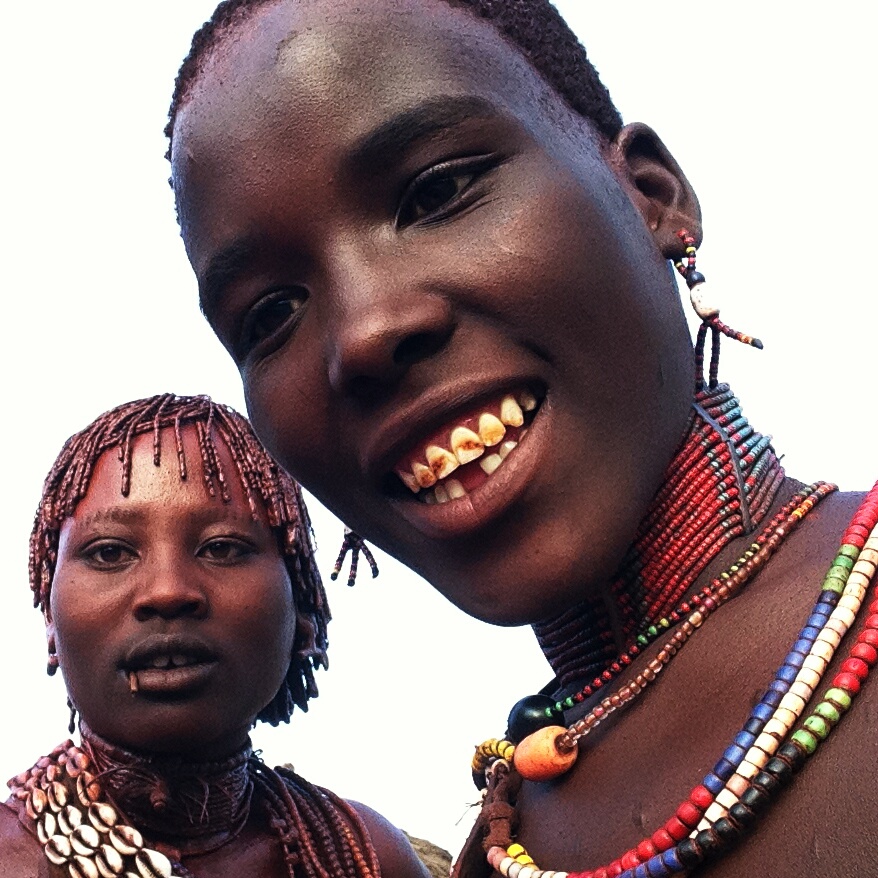…The young man would be holding a vicious switch, cut from nearby bushes and the woman would provoke him into whipping her. The men were usually reluctant, but eventually carried out the task with a whistling swish then a crack as the switch cut into the woman’s skin, either on her back or upper arms. The lower back seemed particularly vulnerable to being opened up. The man had to be whole-hearted about it or she would tell him to do it again, then prance about in disdain at his weak blows…
This is a guest-post by my friend Richard Bates.
Richard is a veteran traveller and a great raconteur.
Over dinner one night, here in Chiang Mai, Richard told me some amazing stories about traveling with his partner, Sandra, in Central Africa.
(Top picture: ritual flogging, in the South Omo Valley, Ethiopia.)
Every traveler journeys for different reasons and sees the world around them through their own unique paradigm.
I’ve never been to Central Africa. Looking through somebody else’s eyes at a place you have never been is so fascinating. It reminded me that travel is a very intimate and personal thing. I’m so grateful to Richard for bringing the Omo to me, so viscerally, and allowing me inside his head to share his adventure.
Richard’s story is the first ‘guest-post’ on the blog, which is very exciting. I love seeing the world through other peoples eyes as much as you do, so Raw Safari is going to be bringing you more posts by guest writers and photographers, soon.
Maybe you have a story or two to tell? Maybe you have some amazing photos you took while you were roaming the planet? If you would like to share your story with the Raw Safari tribe, get in touch!
BTW: When he isn’t tripping on psychedelics in the African outback, Richard spends his time singing humorous songs in a viking helmet. See him in action at Shrewsbury Folk Festival here…
South Omo Valley. Day 2.
Story by Richard Bates.
Photos by Sandra Lee and Richard Bates.
In Ethiopia one week already. We are on a budget 4×4 tour of the lower Omo Valley with Lungo, our guide from Arba Minch, and Daniel, the driver of the LandCruiser.
As we drove south into the desert of the Rift Valley yesterday, we found ourselves going back in time.
The remote tribal people of the South Omo live the same life that they have always lived with a few minor exceptions. Except in the occasional town there are no shops so there is none of the littering of plastic packaging that you see everywhere else in the world. Plastic water bottles and bags are precious items recycled endlessly. There is little to buy so there is no need for money, no electricity so no TVs, no mobile phones or any other IT, no cigarette smoking, no cars or motorbikes.
(Below: calabash and plastic bags, a Hamar woman taking her shopping home.)
We had to pay an entrance fee to village collectives, but for photos, Lungo liked to take us to remote villages that had more need for salt or soap which is what we gave in exchange.
The Hamar women of the Turmi region look just like the photo above: exquisitely beautiful; walking along semi-naked, wearing animal skins; carrying calabashes; covered in beaded jewellery, metal bracelets and cowrie shells; hair braided in ochre and mud.
Day two proved to be the highlight of the whole trip. We were in for a massive day but we didn’t know it yet.
At nine, we continued heading south, driving most of the time on a bush track beside the main dirt road, some parts in the process of construction, others too corrugated to drive on.
We saw baboons almost immediately and the birds came thick and fast.
After about an hour and a half we arrived at a border town. Omorate wasn’t on the border but the closest settlement and our passports were checked. We knew that we were close to the Kenyan border – 26 kms – but what we didn’t know until later was that we were closer, just maybe 5 kms, from South Sudan on the other side of the Omo. We walked down to the bank and jumped into one of the banana-shaped dugout canoes that were shuttling across the swift flowing river and a few minutes later scrambled out on to the mud under the trees on the opposite bank, standing, for all practical purposes, in the newest country in the world: South Sudan.
(Below: crossing the Omo River.)
What we had come over for was to visit a small village (or it might have been the tribe’s name) called Arbora (ironic, as there wasn’t a tree to be seen).
We had to walk straight into the desert for 30-40 minutes under the blazing sun to reach it. It was hot and thirsty work for sure.
There was a closer village that we passed but there was another group there and anyway they were only interested in money, according to Lungo, as everyone goes there. We bypassed it, eventually entering, through the thornbush barricade, into a compound of about 40 huts, about half of them low domes made out of corrugated iron, the rest thatched.
I looked in horror at the metal sheeting and asked ‘who lives in there, isn’t it like a furnace?’
The answer was that the people sleep in there on cold desert nights, warm from the heat of the day, while the rest of the time they are in the thatched huts.
Slowly the villagers began to emerge, mostly children, and once again I scared the bejesus out of one poor little mite, who ran off, then stood at a safe distance in abject terror, sobbing.
In Arbora, we wandered around the village, snatching what shade we could, resting from the heat for the walk back and got some great photos, once again paying in soap. We sat on the verandah of a community health centre that had been built for them but never used.
It was a good photo opportunity. The young boys all had throwing sticks just like aboriginal ones and they showed me how they hunted small game with them.
(Above: Sandra, hanging out with the locals in Arbora.)
After a while we headed back along the shores of a lagoon with hundreds of pelicans resident and returned past the bypassed village on the opposite side. We were joined by the girls in the last photo above from the bigger, first village who said that they wanted soap too, as the miserable tourists in the tour group ahead of us had only given them money for photos. Of course once we had taken the above photo for soap then they wanted us to take more, for money. They accompanied us, quietly wheedling, all the way back to the riverbank.
Young girls this age – about 14 – are already married, having been genitally mutilated. Soon they will have their first babies and we prayed that they wouldn’t end up in a fistula hospital, or worse. They could be at school, but these are hardcore tribes down here. The women and children seem to live a completely traditional life with practically nothing.
The men were hanging out at the ferry crossing on the other side of the river. There used to be a proper ferry across here until it got washed away in a flood. Trucks from Kenya and Sudan would smuggle all sorts of stuff in. By the looks of the tyre tracks in the sand on the Sudan side, maybe they still do?
We crossed back by dugout, and headed toward Turmi.
We ate a disgusting lunch (I am so over injera) at a place where the guys wouldn’t let Sandra use the toilets, because they were so disgusting. We were actually backtracking down the road we had come in on the previous day, but now the dry riverbed of the day before had shallow water flowing after the rain in the night.
After lunch we set out to a Hamer village where we hoped to catch a dowry whipping and bull jumping ceremony.
These are not put on for tourists but outsiders are welcome in return for a donation to the festivities.
We were lucky enough to come in the two months of bull jumping festival season. Several villages would be holding them over coming weeks. They are the real deal and Lungo had managed to find one for us on that day. We were so excited!
Hamer people started appearing as we turned off to the village, heading way inland into the dry hills. It felt as remote as anywhere I have ever been.
As we drove into the village there were lots of 4x4s there, all from tour companies, and it seemed as though we were late.
We were worried that we may have missed the whipping, although we would have been a bit relieved if we did.
The village was jumping with drumming, chanting, bells jingling, horns blowing and a big pot of hooch simmering outside. But that wasn’t where the action was happening and we walked downhill about half a kilometre, to the women’s ceremonial ground where they were getting whipped. We could hear and see it from a distance, and as we approached women were walking past us, blowing their horns, calling out and jingling their leg bells, bleeding from great welts on their backs and arms. It was still in full swing! We weren’t going to miss anything.

Want to learn how to travel the world on $10/day?
Get your FREE e-book: The Travel Hackers Handbook.
Hamer is spelt in several different ways but always pronounced ‘Hammer’. This remote tribe does not practice either female or male genital mutilation, are sexually liberated before marriage – i.e.: the women don’t have to be virgins to marry – so all good, except, they do have the following instead…
As we approached the whipping ground we started to make sense of what was before us. On a flat and wide open area most women were sitting around in groups under the trees ignoring the tourists, who were standing around in their groups not knowing what to do with themselves. What we were most interested in were the little tableaus that unfolded when one of the women would approach a young man.
The young man would be holding a vicious switch, cut from nearby bushes and the woman would provoke him into whipping her. The men were usually reluctant, but eventually carried out the task with a whistling swish then a crack as the switch cut into the woman’s skin, either on her back or upper arms. The lower back seemed particularly vulnerable to being opened up. The man had to be whole-hearted about it or she would tell him to do it again, then prance about in disdain at his weak blows.
Pain didn’t seem to be an issue, but there were some indications that home-made alcohol was used as a pain inhibitor. The women were shining, being covered in some sort of fat as a protective measure. Apparently honey would be rubbed into the cuts the next day, but for today they were left raw.
It was important to the women that they be whipped properly. There was clearly status to be achieved, and many women’s backs were criss-crossed with scars from previous ceremonies. All the women up for whipping wore tank-tops and the like to protect their breasts and that was the only time we saw Hamer women wearing anything on top except for their animal skin throw-overs.
Once the man refused to respond to any more taunts, the woman would dance away singing and blowing on a metal trumpet shaped like a cow horn, jingling her leg bells as she pranced around. It took me most of the afternoon to garner a logical and coherent explanation as to what was going on, so you, dear reader, can go that journey with me and wait a bit to find out. At that moment it just looked like women wanting to be whipped so viciously that they would scar and young men being coerced in to doing so. The women were often seen trying to force switches into the men’s hands.
(Above: the Hamar whipping ceremony. If the men ignore them, or whip them half-heartedly, the women mock their weakness with taunts.)
Our village entrance fee had paid for taking photos, so it was great to wander freely around, mingling with the action without being hassled. In fact, we were ignored at first like the other tourists who kept their distance from proceedings, but that was to change.
Daniel had taken the LandCruiser somewhere and was hanging out with the other drivers, but Lungo had brought a large plastic woven mat that he had spread out under a tree for us to be comfortable (no other guide had thought about this, these ceremonies go on for hours) and water, cigarettes, peanuts and ‘kat’, the narcotic plant that is so popular to chew in Ethiopia and Somalia. I had mentioned to Lungo that I would like to try some and he had thought ‘well, what better place to introduce Richard to kat than at a bull jumping ceremony’.
Needless to say, sitting under the trees with the locals, chewing kat, put us into a different category of tourist than the others. Hamer people shared our mat, our water (hoping for the empty bottle), our cigarettes and our kat. Kat was an interesting experience and true to form with me and mind-altering substances, I quite liked the effect. It is a green leafy shrub and you just stuff a bunch of leaves into your mouth and chew and chew. It is very bitter, so there are usually peanuts on hand to sweeten the palate. It makes your mouth both dry and full of saliva and once you have chewed until there is just a small wad left, you wash it down with water and start again. After about half an hour of this, a mild euphoria starts to wash over you You become very awake and alert, a bit chatty and the effect is not unlike mild speed or half an ecstasy. It is very social. While we were sitting under the tree, the whipping was still going on around us, but there is only so much watching of the whipping of women’s backs into bloody welts that you can take.
As the whipping subsided the men who had been doing it started to get themselves painted up. They were to be the bull jumpers. We now walked up to the central ceremonial area of the village where the action had moved to and most of the Hamer were.
The dynamic now changed.
Lungo set us up under another tree and we went back to kat chewing. Now the village open ground had a circle of painted-up men on one side, chanting and jumping straight up and down, ankle bells jangling. They did this continually for a couple of hours while the women danced from one end of the square to the other, individuals occasionally making a foray into the men’s circle, showing off their bloody backs. Excitement was rising, the noise from all the chanting and bells was quite intense and you could see people’s emotions start to get carried away. All the tourists were herded on to a bank, out of the way, but we continued to mingle, getting the occasional good-humoured threat from a warrior to get out of his way.
Most of the tour groups had been there for hours and were getting visibly disgruntled having missed lunch and now having to watch the natives go on and on. We were completely enthralled, unable to believe what we were seeing, or where we were.
There were maybe 20 men jumping up and down, about 40 women tearing around causing mayhem, watched by 40-50 tourists and surrounded by 100-150 villagers, either watching proceedings or lounging around under shelters, drinking and socialising.
It was at that point that I got a partly coherent explanation of what was going on. This is the best of my limited understanding: it is all about marriage and family ties. The Hamer people, like most people around the world, have a dowry system. Only problem is, they don’t really have anything to give, except probably goats. But what they do have to offer is family loyalty, commitment, and the way that they demonstrate that is by sacrificing their own flesh. So the women of certain families demonstrate their commitment to other families who they hope to marry one of their sisters into, by volunteering themselves to be whipped. And there is a converse outcome. By whipping these women, the men assume certain responsibilities to look after them in the future, a real family tie working both ways.
Meanwhile, the whippers prepare themselves to jump the bulls. Understand that there is no bride and groom yet, this is all about families eyeing each other off and the men qualifying for marriage.
To qualify to approach a family to marry one of their women, the men have to prove their manhood by first whipping the family’s women and then successfully jump the bulls. Failure to do so means that they have to wait two years to try again. They were psyching themselves up for the challenge.
We went back for a break under the tree, more kat chewing and some interaction with the locals. Sandra decided to get her hair braided like theirs and two women beavered away for half an hour or so to work her curly hair into tiny braids. She declined the offer of an ochre and mud finish. There were old men lying around taking snuff, young warriors getting painted up, young women having their photos taken, Lungo and I getting higher and higher. In the background, the festivities and noise reaching fever pitch. It was a trip I can tell you.
The women were fascinated by the selfie function of the iPad, allowing them to use it as a mirror, which they probably didn’t have (and allowing us to take clandestine photos).
I took a photo of one young woman next to me and she said ‘no, no!’
To which I said: ‘Hey! You’re eating my kat’.
They were also fascinated by Sandra’s breasts, pulling at her bra trying to look inside and poking the flesh (are they for real?).
There was also a massive cooking pot with a bubbling alcoholic brew in it, looking just like a cannibal pot. We realised that we were in the middle of a scene that could have been used in an old movie, striking terror of African natives into the hearts of movie-goers.
(Below: everybody loves selfies. That’s Richard’s beard in the background.)
The sun was starting to set. It was time for the bulls.
We all went up to the entrance to the village and crowded around, Hamer and tourist, occasionally having to make a path for a herd of donkeys or goats coming home, and then in came the bulls, about 50 of them.
The young warriors moved amongst them, selecting one each, and parked them side by side in a long line. The other bulls were led off and the jumping began. What the men had to do was to take a running jump, naked, leap up on to the back of the first bull and then run along the line of backs, jump down, turn around and do it again in the opposite direction. We only saw one warrior fall off – clearly not ready for marriage – so he will have to wait another two years to have another go.
That was it.
We all piled into our LandCruisers and took off, leaving no doubt relieved villagers to get on with their party without us: by all accounts a night of revelry that would end up with the young people in the bushes making initial family ties of their own choosing.
The way it works nowadays is that by opening up the ceremony to tourists and charging an entrance fee, the money so collected pays for the after party and feasting for the visiting Hamer who probably have come from all over the place, looking for appropriate genetic diversity and a party.
So that was that, the most amazing cultural experience of my life. But the day wasn’t over yet. Driving back to Turmi in the dark we came across all the vehicles in front of us stopped. The river!
The dry riverbed from the day before was now a flowing stream, knee deep, and not one of the drivers with their massive 4x4s was game to be the first to attempt it. I was all for Daniel being the first, but they were all driving either hire or company vehicles and it would be at their own risk. The crossing had aquired a nasty reputation over the years and although people were having no problem walking across, no-one was prepared to risk a vehicle, despite my kat fuelled enthusiasm:
‘in Australia this is just a trickle. You’ve all got massive LandCruisers. Come on guys, you bunch of pussies! Just do it!’
The situation wasn’t helped by the arrival of vehicles from Turmi, prepared to take us home for a charge, their drivers discouraging our drivers further. In the end we succumbed, practically the last to give up, waded across the river, bargained with a pickup driver to take us back to camp, eventually arriving quite late but with a cold beer and dinner waiting for us. They had heard the news and were waiting up for us. A massive day it had been.
Poor Daniel and the other drivers didn’t get across until the river dropped at midnight. We were sound asleep in our tent by then, the kat having eventually worn off.
I have to say that yesterday was one of the great travel experiences of my life. Maybe just the trek to Annapurna base camp in Nepal beat it.
Note for travelers: we flew to Ethiopia on Ethiopian Airlines, essential if you want to take advantage of a massive 60% discount on their internal flights to all the main towns in Ethiopia.
Buses go everywhere and you can probably hitchhike too, but if you want to avoid long and uncomfortable hours travelling on what can be tortuously slow roads, especially in the mountains, domestic air travel is a cheap way (but only with that international ticket) of exploring this fascinating country.
In Addis Ababa we stayed at ‘Mr Martin’s Cosy Place‘ guesthouse, not far from the airport in Bole. Great family atmosphere, location as good as any in the sprawl of Addis, and value for money. Of our 17 days in Ethiopia we stayed there for seven nights over three occasions, using it as our base.
:-) Richard.
>> More travel stories and photos from Africa.
>> Want to be a guest blogger on Raw Safari? Email me your words and pic’s.
>> Connect with Raw Safari on Facebook.
